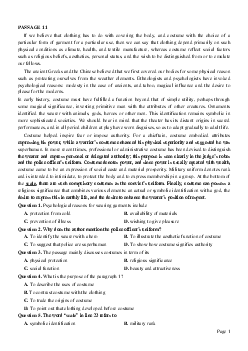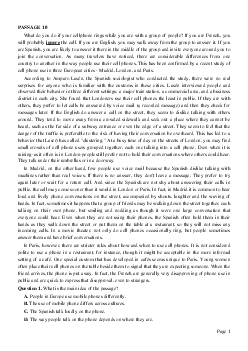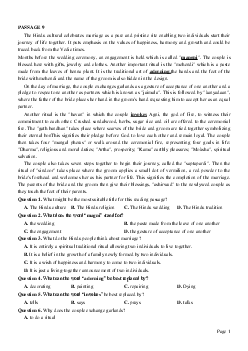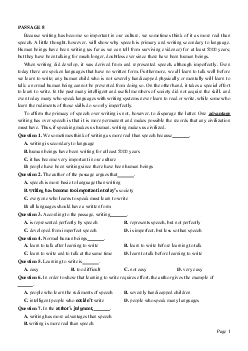


Preview text:
PASSAGE 28
It looked just like another aircraft from the outside. The pilot told his young passengers that it was
built in 1964, a Boeing KC-135 refuelling tanker, based on the 707. But appearances were deceptive, and
the 13 students from Europe and the USA who boarded the aircraft were in for the flight of their lives.
Inside, the area that normally had seats had become a long white tunnel. Heavily padded from floor to
ceiling, it looked a bit like a lunatic asylum. There were almost no windows, but lights along the padded
walls eerily illuminated it. Most of the seats had been taken out, apart from a few at the back, where the
young scientists quickly took their places with a look of apprehension.
For 12 months, science students from across the continents had competed to win a place on the flight
at the invitation of the European Space Agency. The challenge had been to suggest imaginative
experiments to be conducted in weightless conditions.
For the next two hours the Boeing's flight resembled that of an enormous bird which had lost its
reason, shooting upwards towards the heavens before hurtling towards Earth. The intention was to
achieve weightlessness for a few seconds.
The aircraft took off smoothly enough, but any feelings that I and the young scientists had that we
were on anything like a scheduled passenger service were quickly dismissed when the pilot put the plane
into a 45-degree climb which lasted around 20 seconds. Then the engines cut out and we became
weightless. Everything became confused, and left or right, up or down no longer had any meaning. After
ten seconds of free-fall descent the pilot pulled the aircraft out of its nosedive. The return of gravity was
less immediate than its loss, but was still sudden enough to ensure that some students came down with a bump.
Each time the pilot cut the engines and we became weightless, a new team conducted its experiment.
First it was the Dutch, who wanted to discover why cats always land on their feet. Then it was the
German team, who conducted a successful experiment on a traditional building method to see if it could
be used for building a future space station. The Americans had an idea to create solar sails that could be used by satellites.
After two hours of going up and down in the plane doing experiments, the predominant feeling was
one of exhilaration rather than nausea. Most of the students thought it was an unforgettable experience
and one they would be keen to repeat.
Question 1. What does the writer say about the plane? A. It had no seats. B. It had no windows.
C. The inside was painted white.
D. The outside was misleading.
Question 2. What does 'eerily' in paragraph 2 mean? A. badly B. brightly C. clearly D. strangely
Question 3. What did the pilot do with the plane?
A. He climbed and made the plane turn over.
B. He climbed and made the plane fall slowly.
C. He quickly climbed and stopped the engines.
D. He took off normally and then cut the engines for 20 seconds.
Question 4. What does the word it in the last paragraph refer to? A. the exhilaration B. the opportunity C. the plane D. the trip Page 1
Question 5. Why was this text written?
A. To encourage young people to take up science.
B. To describe the outcome of a scientific competition
C. To report on a new scientific technique.
D. To show scientists what young people can do. ĐÁP ÁN 1-D 2-D 3-C 4-D 5-B
LỜI GIẢI CHI TIẾT Question 1:
Nhà văn nói gì về máy bay?
A. Nó không có chỗ ngồi. B. Nó không có cửa sổ.
C. Bên trong được sơn màu trắng.
D. Bên ngoài đã gây ra hiểu lầm.
=> Dẫn chứng: But appearances were deceptive, and the 13 students from Europe and the USA who
boarded the aircraft were in for the flight of their lives.
Dịch: Nhưng với vẻ ngoài gây hiểu lầm, và 13 sinh viên từ Châu Âu và Hoa Kỳ đã lên máy bay đã ở
trong chuyến bay của cuộc đời họ. Question 2:
'eerily' trong đoạn 2 có nghĩa là gì? A. xấu B. rực rỡ C. rõ ràng D. lạ lùng
=> There were almost no windows, but lights along the padded walls eerily illuminated it.
Dịch: Hầu như không có cửa sổ, nhưng ánh sáng dọc theo các bức tường chiếu sáng nó một cách lạ lùng. Question 3:
Phi công đã làm gì với máy bay?
A. Anh ta leo lên và làm cho máy bay quay đầu.
B. Anh ta leo lên và làm cho máy bay rơi chậm.
C. Anh nhanh chóng leo lên và dừng động cơ.
D. Anh ta cất cánh bình thường và sau đó cắt động cơ trong 20 giây.
=> Dẫn chứng: Everything became confused, and left or right, up or down no longer had any meaning.
After ten seconds of free-fall descent the pilot pulled the aircraft out of its nosedive. Each time the pilot
cut the engines and we became weightless, a new team conducted its experiment.
DỊch: Mọi thứ trở nên rối rắm, và trái hay phải, lên hay xuống không còn ý nghĩa gì nữa. Sau mười giây
rơi tự do, phi công đã kéo chiếc máy bay ra khỏi mũi. Mỗi lần phi công ngừng động cơ và chúng tôi trở
nên không trọng lượng, một nhóm mới tiến hành thí nghiệm. Question 4:
Từ “it” trong đoạn cuối đề cập đến điều gì? A. niềm phấn khởi B. cơ hội C. máy bay D. chuyến đi Page 2
=> Dẫn chứng: Most of the students thought it was an unforgettable experience and one they would be keen to repeat.
Hầu hết các sinh viên nghĩ rằng đó là một trải nghiệm khó quên và họ sẽ muốn lặp lại. Question 5:
Tại sao văn bản này được viết?
A. Để khuyến khích những người trẻ tuổi tiếp nhận khoa học.
B. Để mô tả kết quả của một cuộc thi khoa học
C. Để báo cáo về một kỹ thuật khoa học mới.
D. Để cho các nhà khoa học thấy những gì những người trẻ tuổi có thể làm.
=> For 12 months, science students from across the continents had competed to win a place on the flight
at the invitation of the European Space Agency. The challenge had been to suggest imaginative
experiments to be conducted in weightless conditions.
Dịch: Trong 12 tháng, các sinh viên khoa học từ khắp các châu lục đã cạnh tranh để giành được một vị trí
trên chuyến bay theo lời mời của Cơ quan Vũ trụ Châu Âu. Thách thức là đề xuất các thí nghiệm tưởng
tượng được thực hiện trong điều kiện không trọng lượng. Page 3




